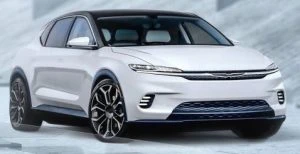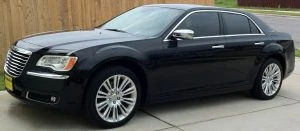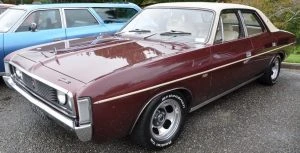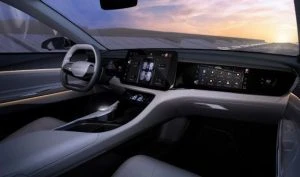Electric Vehicles (EVs)
Chrysler Airflow EV Concept

Chrysler Airflow EV Concept
For me, there are two cars in particular I enjoy seeing, and both for which proudly wear the Chrysler badge. I always take the time to admire them every time I walk past one on the street, or I’ll enjoy watching one as it rolls by out on the road. For me, the Chrysler 300 and the Chrysler Valiant are two great looking cars that provide plenty of power, comfort, and a special drive.
The Chrysler 300 came directly out of the American Chrysler line-up, and it offered a gangster-style (chunky, high waistline, plenty of power, large grille) with luxury and comfort, sedan or wagon. The Chrysler Valiant was a full-size car which was sold by Chrysler Australia between 1962 and 1981. To begin with, Chrysler Australia received the Plymouth Valiant from the United States and rebadged it to sell to the Australian market. However, from the second generation, which was launched in 1963, the Valiant was fully manufactured in Australia. The late 70s versions of the Valiant was my favourite.

Chrysler 300

Chrysler Valiant
So, what’s happening in Chrysler’s corner today?
January 2014 saw Fiat S.p.A. announce a deal to purchase the then struggling Chrysler brand, making Chrysler Group a subsidiary of Fiat S.p.A. In May of that year, Fiat Chrysler Automobiles (FCA) was established by merging Fiat S.p.A. By the end of the year, this group was renamed FCA US LLC to reflect the Fiat-Chrysler merger.
In 2021, Stellantis N.V. was formed, which is a multinational automotive manufacturing organization that is made up of a half-and-half merger between the Italian-American company Fiat Chrysler Automobiles (FCA) and the French PSA Group. Stellantis is headquartered in Amsterdam, and, in terms of a global scale, in 2021 Stellantis was rated as being the world’s 5th largest automaker behind Toyota, Volkswagen, Hyundai, and General Motors.
Though at the moment there aren’t a load of new cars with the Chrysler logo coming out, Stellantis is aiming to be an all-electric brand before 2030. At a recent show in America, Stellantis revealed a rather nice-looking Chrysler Airflow concept, suggesting that there is a lot more to come from Chrysler in the future.
Inside the Chrysler Airflow cabin is seating for four. Plenty of recycled materials and vegan leather are just some of the interior features on offer. It is a luxury car with a full panoramic glass roof, ambient lighting, and excellent sound proofing.

Chrysler Airflow EV Concept
Underpinning the new STLA EV platform, Stellantis made the Chrysler Airflow concept a reality, choosing this car for showing off the Airflow’s latest innovative drive-system technology that is fully connected to customer interaction and advanced mobility. The Airflow emphasises Stellantis’ desire to be cutting edge, to keep up with connectivity, and to produce sophisticated digital interaction.
The Chrysler Airflow EV concept boasts STLA Brain and STLA Smart Cockpit technology that connects passengers with their own digital lives. Thus, there are display screens front and rear, which are configured to suit each occupant, and these individual screens can interface with other screens inside the car using sweeping gestures. Each seat has its own camera, which can also be used for video conferencing as well as selfies. The Airflow EV also has autonomous driving capability, with power delivered by two electric motors, one on the front axle and one on the rear axle. Each electric motor on the concept Airflow boasts 150 kW, with a driving range said to be somewhere in the vicinity of 550–650 kilometres.
Certainly, the Chrysler Airflow EV concept is a neat looking Electric Vehicle, with tidy exterior lines, excellent aerodynamics, a long wheelbase, and a wide stance with a low profile. It would be swift, luxurious transport, fitting for the Chrysler brand, and a nod to the Chrysler greats.
Becoming Greener, Saving Money, and Other Ways to Get About

It’s always a prudent idea to have a little bit of cash tucked away for a rainy day. As much as we like to drive, there are some other ways of getting to work or the shops, especially if you’re one who lives in a city or town, which will probably be most of us.
“I wish I had a little more cash in the bank!” is a phrase that’s been around since Noah, and I guess he too might have looked at getting a higher paid job to cope with the rising costs of timber, building materials, fuel, and other important goods and services. For some of us, the reality is that our current job is pretty good, anyway. So, what are some things we can do when we feel we need to be saving a little more money for other things (e.g., that weekend away to Fiji or paying for that school sports trip to NZ that one of the kids has to go on)?
Getting from A to B every day of the week does draw down on any spare cash, and once you’ve made the switch to a smaller car, a hybrid or – lucky for some – even a new EV, you are left scratching around for other options to cut costs. Is there anything else that can be done then to reduce our fuel, EV power bill, and our carbon footprint?
On sunny days – and we have a few of those in Australia – why not take the bike instead of taking the car? If your work premises is under 30 minutes away by bike, then cycling is a great way to keep yourself fit, also ensuring that the times when you do dust off the car to take it out for a spin become even more fun and rewarding.
Using your car less and biking or walking more is going to be good for keeping your body in shape. Now that’s a great incentive if you’re on the lookout for someone special or even if just maintaining the special relationship you do have. How cool is that, maintaining your sexiness and letting more cash build up in the bank for that holiday away or “Johnny’s or Jenny’s” school sports trip. Of course, if you have to take half a dozen kids to school, take a load of gear or a trailer, or if it’s simply pouring with rain, then you’re probably going to want to stick with your car for transport. However, shorter distances can also be walked – even with a brolly in the pouring rain!

Governments, town planners, and urban designers are all trying making it easier for cyclists to be able to bike safely, pedestrians to go walk about, all while working towards cleaning up the air quality of our urban environments – particularly the congested city environment. I do love a ride on the pushbike. The wind in the hair, the sun on the back, and the blood pumping through the veins feels great.
But what about the bus or train? Does your public transport system provide a better alternative to your vehicle’s thirsty internal combustion engine? If you can find a public transport route that takes you within half a kilometre of your work, why not use public transport and walk the remainder? You’ll get to stretch your legs before arriving at your office, and this will help your work productivity – especially first thing in the morning. Buses are usually comfortable enough in Australia, while the train is also available in many of our main centres.
I guess if it’s time for getting the groceries, the bus or train might not be a practical option; it is hard work carrying all those shopping bags full of milk and eggs. The grocery run is definitely easier to do by car. Doing the groceries weekly or even fortnightly rather than less frequently saves you petrol money and also grocery money – it’s a fact! Flip the coin, and I suppose lots of little shopping trips everyday by bus or train could also get the groceries done.
But is everyday shopping practical or relaxing? Maybe not for busy Mums and Dads, or workaholics, but it is probably more attractive for older people who haven’t quite the same work and family commitments.
Of course, there will be a number of you smirking as you read this because your work office is at home. Yes, I agree, that’s a pretty cool set up! Rolling out of bed in the morning and into your office chair sounds like a great way to get to work. Still, there are ways, I’m sure, that you could reduce the level of car trips you do in a week, especially if you needed to save a few extra dollars for various reasons.

Still not convinced that you can give up the car entirely? Actually, it is pretty hard in this day and age to go carless. All of us need to be able to get out of town and see the countryside from time to time – it’s healthy and the Doctors would agree! However, there is another phenomenon known as carpooling. You could carpool with the people at your work. Single-occupant vehicles (i.e., one person in one car) are frowned on by town planners, environmentalists, and traffic engineers, so if you can share the ride with someone else via a carpool system, you will be impressing these types. You will also get to save money, and you can relax a little, feeling a bit better about how you’re helping to reduce traffic congestion, your own carbon footprint, and the urban air pollution.
Of course, if you love cars, then you are going to want to drive yourself everywhere. Best save up and buy a hybrid or EV, then!

Let’s Torque ICE and EV Physics

As technology improves with each passing year, the inside mechanicals of an internal combustion engine (ICE) have become more refined, stronger, lighter, and more efficient at harnessing power from the combustion process and feeding it out to the wheels. Adding Hybrid technology to the ICE has also enabled car manufacturers to make greater gains in power and efficiency. Hybrid engines are designed to try and use electric power from the electric motor(s) instead of fossil fuel power from the ICE for as much of the commute as possible. When required, the ICE takes over the power delivery when electric power has been drained, or electric and ICE can work together for enhanced power on acceleration. Purely electric vehicles (EVs) don’t have combustion energy but can still produce phenomenal levels of power and torque.
If you’ve ever taken the slightest look at any car review in a magazine or online, or even browsed through a car brochure, somewhere in the read you’ll come across some of the main bits on the engine stats and specs. Some of the specs are easy enough to understand – like the 0–100 km/h time measured in seconds, which is a measurement of the quickest time it takes the car to go from a standstill to 100 km/h. 100 km/h is equivalent to 62.14 mph, so if you are presented with an Imperial measurement looking at the 0–60 mph sprint (USA reviewers use this), it’s roughly the same as the usual nought-to-the-ton metric figure.
However, some specs are a bit harder to get a handle on – like power output. Power is described as the rate at which work is done, or else the rate at which energy is converted into motion. In cars and vehicles of all types, the formula for calculating power is relatively complicated (or kind of). The power output of an engine is measured in kW (kilowatts) using metrics, which is the force times the velocity: power = work/time = (force x distance)/time.
All sorts of things go into delivering the power and torque created from an ICE out to the road, such as the number of cams (pistons) in the engine, the number of combustion chambers in the engine, the flywheels, the gear set, the tyres, and even the size of the combustion chambers. The reason why EVs can make power and torque quickly and efficiently is that they do away with all the internal mechanical workings of an ICE (the ICE motor) and use magnetism instead of combustion for making power and torque available to the driveline.
Yes, power actually used to be measured in horsepower, which was originally used to compare how well a steam engine or traction engine could work in comparison to a big Clydesdale horse (hp). Here’s some stats for you:
1 kW equals 1.34 hp
1 kW equals 737.56 foot pounds per second
1 hp = 550 foot-pounds per second (ft lb/s)
1 hp = 0.75 kW
As you may already know, power is closely related to torque. Torque is a measure of the force that can cause an object to rotate about its axis point. The whole set-up with a vehicle’s engine, transmission, and drivetrain involves rotational motion, so where the rubber finally hits the road is where the final delivery of the torque from the vehicle’s engine and mechanical components are then converted back to straight-line motion, where and when the rubber applies a force to the road.
Torque is measured in Newton meters (Nm). Newton metres are the metric units used for torque. The non-metric unit used for American cars is in pound-force per feet, also known as pound-feet. Just to be confusing, pound-feet is also used for torque, while foot-pounds are used for power, something that’s likely to drive you half dotty. However, the formula for conversion is 1 pound-foot = 1.356 Nm.
An ICE engine loses a lot of its initial combustion power and torque as this gets delivered mechanically to the rubber on the road, where all the action happens. All the weight and friction of the moving ICE powerplant components drain the power and torque levels before what’s left of it is delivered to the wheels, the rubber on the road used for motion.
Hybrid vehicles (those that combine electric and ICE motors) can use electric motors to boost ICE power and torque output, thus improving fuel efficiency and power and torque delivery. EVs can deliver so much more power and torque to the rubber on the road because they haven’t got all the extra weight and friction of the ICE’s mechanical componentry. EV motors don’t need all of this to create a big enough force for motion.
Hybrids, EVs, and the City Environment

With the big push for clean air and protecting the environment, running a new hybrid vehicle is one way to make the gradual change from fossil fuels to electric more affordable and realistic as we head into a future of EVs.
A gradual change is key, so that everyone can adjust their budgets and business direction accordingly. And making the change gradual ensures that EVs can become more affordable to the masses. Have you heard of the ‘trickle-down effect’? This term refers to the reality of fashion trends flowing from the wealthy (e.g., politicians, mayors, doctors, directors, engineers etc.) to the less well-off or the working class (e.g., factory hands, beneficiaries, shop assistants, cleaners, farm workers, etc.) in society. This trickle-down phenomenon can be related to any new consumer product, especially when these products are first introduced into the market.
At the product’s initial introduction into the marketplace, it is costly and only affordable to the wealthy, but, as the product matures, and as time goes on, its price begins to fall so that it might become more widely affordable and thus adopted by the general public and the working class. One would assume that pure EVs will follow this kind of trend.
Right now, EVs are expensive to purchase new, especially when you want to have one of the EVs with all the status (e.g., Tesla, Porsche, Mercedes Benz). There are some cheaper options like the MG ZS EV, Hyundai IONIQ electric, the Nissan Leaf, and the Hyundai Kona electric. These cars can generally be had for less than $60k.
Currently, owning and operating a 100% EV would be an ideal option if you just wanted to hop between addresses inside the city boundary or maybe commute short distances to and from the urban jungle. However, throw in some intercity travel or long country drives, and the EV is simply left wanting. I’m aware that EV manufacturers are working hard to change this, to make their EVs capable of travelling much longer distances between recharges, as well as making the recharge time much quicker than it commonly is. As it stands today, Australia’s recharging infrastructure is in its infancy, and beyond the city boundary, even inside, it still has a long way to go before becoming seamless and brief.
If you live in and mostly travel inside one of our lovely Australian cities, owning or operating a vehicle that is capable of running on electric power for all or at least some of the time (more depending on you commute or travel patterns) would surely be an option if you aren’t doing so already. This would instantly help to improve the air quality of the congested city environment.
Who wouldn’t want to enjoy breathing cleaner air inside a city’s boundaries? We all would, right? But I can’t afford an EV because (a) it’s not practical and (b) you can’t afford one? If you relate to either of these truths, then you aren’t alone and are currently in the majority. So, what about a Hybrid then? Right now, hybrid vehicles do make a lot of sense. They are able to use their small electric motor for 20–30 km of inner city travel, thus making the city air cleaner and the environment better for all city dwellers and workers. However, when the commute includes distances beyond the city boundary, the petrol motor will happily take over transport duties and to get you where you want to go, recharging the electric motor’s battery in the process.
Of course, a bicycle or even walking is another option for inner city travel, particularly when it isn’t raining. If you are wanting a Hybrid vehicle or even an EV, then do have a look at some of our Hybrid and EV reviews or talk to some of our sales staff to see if there is a likable and affordable option out there for you.